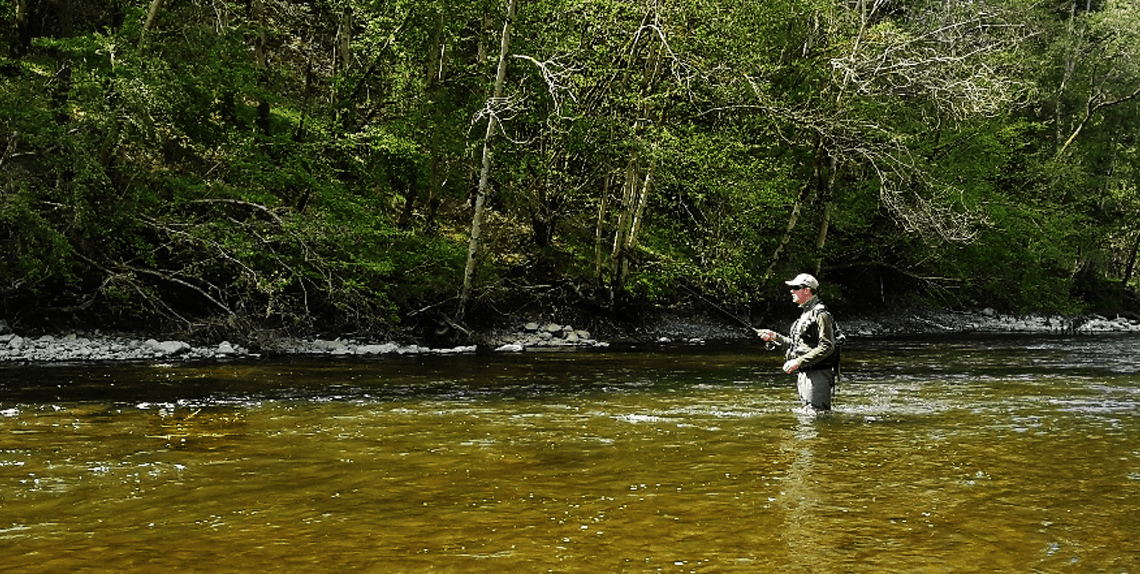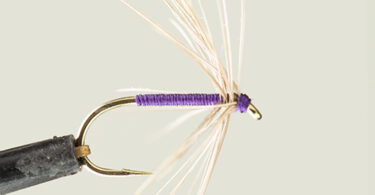It was in mid 2009 that I started to delve into french leader techniques after reading an interesting article on the method in the angling press. The article was fairly brief about the methodology and practicality of its application but it was majorly thought provoking. What is it? Where do I fish it? How do I fish it? Further research followed and the majority of information on the method was gleaned from the pages of forum message boards. The basic principles seemed to be a long rod and a long leader, crystal clear water, spooky fish, short dead drifts, small flies and fine tippets.

French leader at range Cumbrian Derwent
I started off with a 10ft 3 weight and a 15ft 0X Salmon leader to this I attached a crude indicator of yellow Stren 8lb line. I took myself away from my comfort ‘go to’ areas for Duo and Czech nymph and began to explore the thin fast water above. Casting the 2 gold head bead flies upstream, lifting the leader and indicator off the water by raising the rod to 45 degrees. I tracked the indicator back taking up any slack by lifting the rod higher through to 90 degrees to keep the indicator at the same rate as the flow back towards me. It was a relatively short cast in fast water so drift time was 4-5 seconds. I soon discovered with a flick of the rod the flies could be re cast back into the run with a fluid motion and another short run through followed. Multiply this 10-20 times and the width of river was covered before a step upstream and the process repeated again. As I explored the run the indicator ‘stabbed’ away from me a few times as the point fly caught the bottom, but suddenly the river pulled back and a trout soon came to hand. I stood back in bewilderment that a fish had been taken from such fast ankle deep water. The river had been unlocked.
Fast forward a few seasons and the salmon leader had been replaced with a 9m Hends Camou leader, the crude stren had been replaced with a highly visible and sensitive bi colour braided indicator and the gold head beads with jig hook patterns. The 10ft 3 weight had been upgraded to an 11ft 3 weight and every inch of the river is now being fished, not walked past as before to the comfort zones.
I have discovered with the longer 9m leader I can comfortably fish 3 to 4 rod lengths out with all the leader and indicator held off the water so the 2 flies can dead drift. The bi colour indicator appears to hang in the air and allows you to detect the slightest of takes but at the same time anchors the leader under relative tension to the rod tip. Anything abnormal to the drift of leader in the river should be met with a flick of the wrist to contact with a fish or dislodge from a stone to continue the drift. Over time you will develop a sixth sense and react to the deft pause of the indicator to feel the rod kicking away with a fish.

Perfect example of french leader water, shallow fast in the neck/medium-fast run gaining depth
The areas I concentrate on with 2 nymphs using french leader techniques are medium-fast paced runs right up into the shallow white water of the neck. I often find the best fish are found in the shallowest fastest part of the run in summer with takes often lightning fast and violent.
The method is not solely confined to fast shallow water and nymphs. It can be used to great effect in slower glides casting at a more acute angle upstream to allow the flies to gain depth and by greasing the indicator allowing this to lie on the surface and with the leader held off. I have even had the full 9m out of the rod tip fishing a single dry fly for spooky fish with the taper allowing a nice turnover and zero disturbance on the surface. Drifts still have to be relatively short as the heavier tapered section of the leader can begin to sink but it is a good way to cover rising fish if a hatch suddenly starts without having to change rods.

Hends Camou french leader 9m, bi colour braided indicator, 2.5mm slotted tungsten bead size 16 jig hook flies
The final make up of the french leader setup is fairly straight forward with 6ft 7x tippet direct from the bi colour indicator (attached direct to the 9m Camou) to a dropper around 2 inch long and then a further 2ft of 7x to point fly. If the bottom is snaggy then I recommend 6x but the finer tippet the better as this cuts through the water column in fast water due to less drag. The flies are tied on size 16 jig hooks, to avoid catching the bottom, with 2-2.5mm slotted tungsten beads.
Click here for article with French Nymph Leader set up diagram
Unless the river is at real summer lows I will use two 2.5mm flies without excessive hold ups on the bottom. If the flies do catch bottom part way into the drift they are generally fishing too deep, so either shorten the drift time or open the angle of your cast and fish more square to the riverbank. Resist the temptation to go lighter with the beads. The extra weight is needed to get the flies into the ‘taking zone’ faster, under control with minimal slack allowing you to detect the most sensitive takes. Too light a fly will get caught in the current and can be taken and rejected by a fish without the indicator moving as there is no relative tension in the tippet/dropper section to the bi colour braided indicator held above the surface. I must stress this is not a tension that is touch tight like czech nymphing and pulling the flies through the water column, but a relative tension where the whole system from point fly through tippet to indicator through leader to rod tip is visually taught. This is the secret to the method’s success, line control is king.

Tight Lines!




